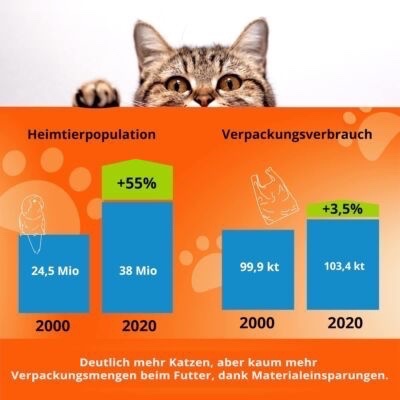Packaging
Wait a minute – increasing packaging consumption despite optimised packaging?

Friday 05. August 2022 - Lighter and lighter packaging that requires less material and raw materials - and at the same time we consume more and more of it per year. How can that be? The Society for Packaging Market Research (GVM) is also looking into this.
In a current study, it examines the development of the total consumption of packaging between 1991 and 2020 – and what influences it. Because between 1991 and 2020, the amount of packaging increased by 14 per cent (which corresponds to 1 million tonnes).
8.7 million tonnes – that’s how much packaging private end consumers:inside generated in 2020. 6.5 per cent of their packaging consumption in 2021 comes from detergents, cleaning agents and personal care products, for example. The amount of packaging for these products has increased from 82,200 tonnes to 200,800 tonnes since 1991. Essentially, three factors determine these developments: Volume, structural and weight effects. It sounds complicated – but it is easy to explain.
We buy more
Changes are also a result of consumer behaviour. If we buy more detergent or hand cream in plastic packaging, this has a quantity effect on the amount of packaging. This means that we, as consumers, have a significant share in the increasing amount of packaging. If we consumed as many products today as we did 30 years ago, we could do without 1.7 million tonnes of packaging.
Trend towards smaller packaging sizes
There are more and more households with only one or two members. Each of them buys for himself. So in total, more people buy more products. However, they usually do not need large quantities of a product. Such structural effects increase the amount of packaging. For the same amount of product, more packaging is needed due to the smaller portion sizes. In addition, the products have to be bought more often.
Weight counts
The weight effect also influences total consumption. Bottles and canisters, for example, are becoming lighter and lighter. This is because the industry is optimising the material used in order to use fewer raw materials in production. On the other hand, there are more and more spray bottles whose spray guns weigh more than a pure screw cap.
In 2020, almost every second household (47 %) had a pet. Dogs (in 21% of households) and cats (in 26% of households) are particularly popular. Since 2000, the cat population has increased from 6.8 to 15.7 million cats and the number of dogs has doubled (10.7 million in 2020). More and more pets means more and more pet food – the quantity effect occurs. In addition, there is the structure effect: there is also an ever greater choice of food for animals, but small snacks in particular are booming. In addition, pet food is also increasingly being filled in smaller quantities, although there is also the opposite trend towards large bags of food. Instead of one large package, however, small multipacks are often offered.
Optimisation for more sustainability
Structural and volume effects are thus increasing the total consumption of packaging – this is down to us consumers. Fortunately, the industry can cushion the increase through the weight effect: Packaging has become lighter and more efficient since 1991 thanks to eco-design. They use less and less material and fewer raw materials. Without these optimisations, packaging consumption in 2020 would not be 8.7 million tonnes, but 10.2 million tonnes.
The positive weight effect is also evident in the packaging for pet food: despite the enormous consumption and changed supply, the amount of packaging has only increased slightly in the past 20 years: from 99.9 million tonnes (2000) to 103.4 million tonnes (2020). If nothing had changed in packaging design since the turn of the millennium, we would have consumed a full 246 million tonnes of pet food packaging in 2020 instead!
You are now asking yourself why the industry continues to rely on plastic packaging when packaging consumption continues to rise? Because plastic packaging makes sense. They are light, flexible and protect against moisture, oxygen and shocks. They prevent products from becoming contaminated or losing quality. If this happens, they have to be replaced. This is not only a burden on the wallet, but also on the climate and our resources. The packaged products pollute the climate many times more than the packaging.
Plastic packaging also scores points over other materials such as paper or glass in that it requires less energy in production, requires less transport and also causes fewer CO2 emissions. So plastic packaging also makes sense from an ecological point of view.
But the sustainable impact falls by the wayside if progress is slowed down by growing consumption. Whether industry, trade or consumers: There is no single game changer – climate protection is the result of responsible decisions by each individual. This includes our lifestyle and especially our consumption behaviour.
